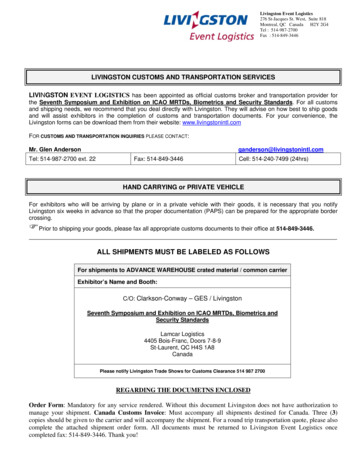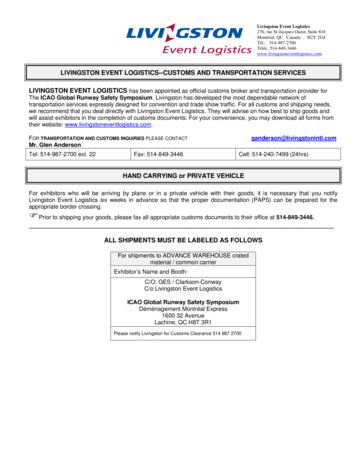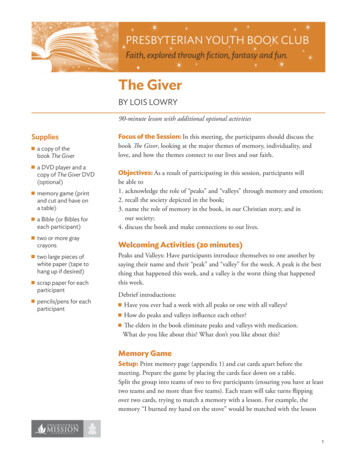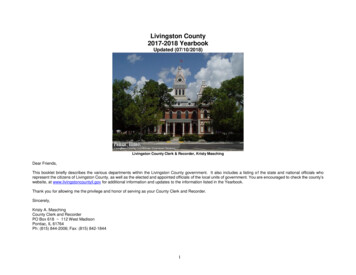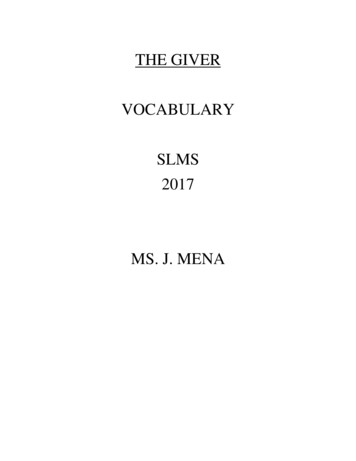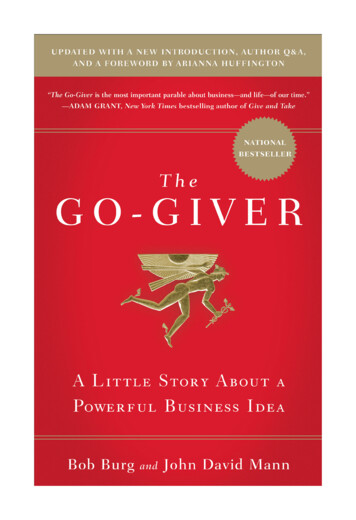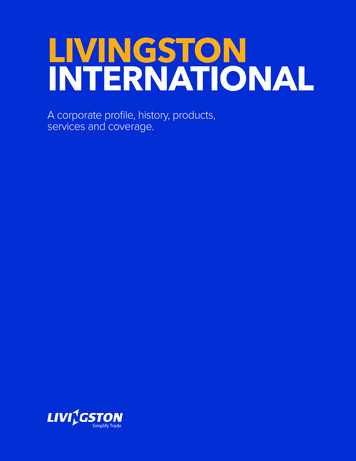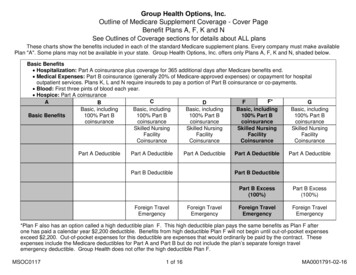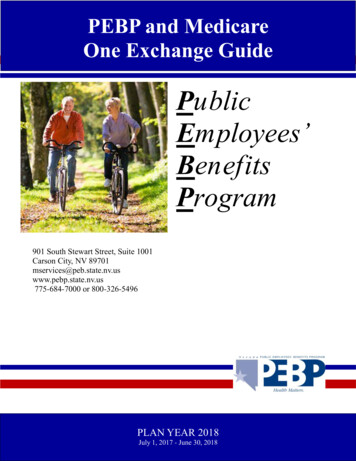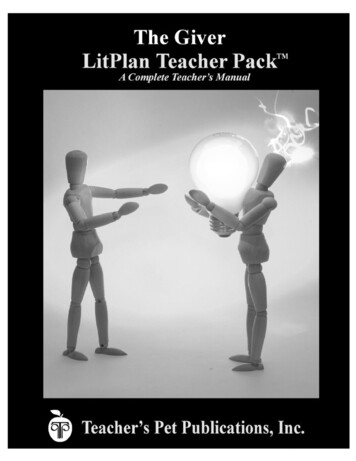
Transcription
TEACHER’S PET PUBLICATIONSLitPlan Teacher Pack forThe Giverbased on the book byLois LowryWritten by Barbara M. Linde, MA Ed. 1997 Teacher’s Pet Publications, Inc.All Rights Reserved
This LitPlan for Lois Lowry’sThe Giverhas been brought to you by Teacher’s Pet Publications, Inc.Copyright Teacher’s Pet Publications 1997Only the student materials in this unit plan (such as worksheets,study questions, and tests) may be reproduced multiple timesfor use in the purchaser’s classroom.For any additional copyright questions,contact Teacher’s Pet Publications.www.tpet.com
TABLE OF CONTENTS - The GiverIntroductionUnit ObjectivesUnit OutlineReading Assignment SheetStudy QuestionsQuiz/Study Questions (Multiple Choice)Pre-Reading Vocabulary WorksheetsLesson One (Introductory Lesson)Nonfiction Assignment SheetOral Reading Evaluation FormWriting Assignment 1Writing Evaluation FormWriting Assignment 2Writing Assignment 3Extra Writing Assignments/Discussion ?sVocabulary Review ActivitiesUnit Review ActivitiesUnit TestsUnit Resource MaterialsVocabulary Resource Materials36891013244561687173757986889597105139155
A FEW NOTES ABOUT THE AUTHORLOWRY, LOIS (1937-). Lois Lowry is the author of over twenty juvenile novels, and has contributedstories, articles, and photographs to many leading periodicals. Her literary awards are numerous andextensive. She once said that she gauges her success as a writer by her ability to "help adolescents answertheir own questions about life, identity, and human relationships."Lois Lowry was born on March 20, 1937, in Honolulu, Hawaii. At the time of her birth, Lowry's father,Robert, a career army dentist and officer, was stationed near Pearl Harbor. The family separated with theonset of World War II, and Lowry spent the duration of the war with her mother's family in the Amishcountry of Pennsylvania. Much later, Lowry's wartime experience inspired her fourth novel, AutumnStreet. As an author, she has often translated her life into fiction for the purpose of helping others who mayhave suffered under similar circumstances.Memories of her childhood, as well as her experiences as a parent, have led Lowry to her most popularcharacter, Anastasia Krupnik, the spunky, rebellious, and irreverent adolescent who stars in a series ofbooks that began in 1979. The broad audience appeal of the first Anastasia book prompted Lowry towrite another novel featuring her heroine, "I have the feeling she's going to go on forever--or until I get sickof her, which hasn't happened yet." Subsequent Anastasia titles number nine at the current time.In 1990- Lowry received her highest honors. She was awarded the Newbery Medal, National JewishBook Award, and Sidney Taylor Award from the National Jewish Libraries, all for her World War II taleof Nazi-occupied Denmark, Number the Stars. In this novel she created suspense and tension withoutwavering from the viewpoint of Annemarie, a child who shows the true meaning of courage. Based on afactual account, the inspiration for this novel came from the stories told to Lowry by a friend who washerself a child in Copenhagen during the long years of the German occupation. In 1994, she was againawarded the Newbery Medal for The Giver.With so many accomplishments in the field of children's literature to her credit, Lowry reflects on her careerin the following manner: "When I write, I draw a great deal from my own past. There is a satisfying senseof continuity, for me, in the realization that my own experiences, fictionalized, touch young readers in subtleand very personal ways." Ms. Lowry divides her time between Boston and New Hampshire.4
THE NEWBERY MEDALThe Newbery Medal is named in honor of John Newbery (1713-1767), a British publisher and booksellerin the 1700s. Newbery is known as the father of children's literature because he was the first to proposepublishing books specifically for children. The award is presented each year by the American LibraryAssociation to the "author of the most distinguished contribution to American literature for children"published during the preceding year. The award was first given in 1922 and is awarded annually. Thewinning book receives the Newbery Medal and one or more runners-up are also recognized as 94019301922TITLEAUTHORThe View From SaturdayElaine L. KonigsburgThe Midwife's ApprenticeKaren CushmanWalk Two MoonsSharon CreechThe GiverLois LowryMissing MayCynthia RylantShilohPhyllis Reynolds NaylorManiac MageeJerry SpinelliNumber the StarsLois LowryJoyful Noise: Poems for Two VoicesPaul FleischmanLincoln: A PhotobiographyRussell FreemanThe Whipping BoySid FleischmanSarah, Plain and TallPatricia MacLachlanThe Hero and the CrownRobin McKinleyDear Mr. HenshawBeverly ClearyDicey's SongCynthia VoigtA Visit To William Blake's InnNancy WillardJacob Have I LovedKatherine Ann PattersonA Gathering of DaysJoan W. BlosSounderWilliam H. ArmstrongOnion JohnJoseph KrumgoldThe Door in the WallMarguerite di AngeliDaniel BooneJames DaughertyHitty, Her First Hundred YearsRachel FieldThe Story of MankindHendrik Willhem5
INTRODUCTIONThis unit has been designed to develop students' reading, writing, thinking, listening and speaking skillsthrough exercises and activities related to The Giver by Lois Lowry. It includes twenty lessons, supportedby extra resource materials.The introductory lesson introduces students to one main theme of the novel through a group discussionof different types of communities. Following the introductory activity, students are given an explanation ofhow the activity relates to the book they are about to read.The reading assignments are approximately twenty pages each; some are a little shorter while others area little longer. Students have approximately 15 minutes of pre-reading work to do prior to each readingassignment. This pre-reading work involves reviewing the study questions for the assignment and doingsome vocabulary work for 8 to 10 vocabulary words they will encounter in their reading.The study guide questions are fact-based questions; students can find the answers to these questions rightin the text. These questions come in two formats: short answer or multiple choice. The best use of thesematerials is probably to use the short answer version of the questions as study guides for students (sinceanswers will be more complete) and to use the multiple choice version for occasional quizzes. If yourschool has the appropriate machinery, it might be a good idea to make transparencies of your answer keysfor the overhead projector.The vocabulary work is intended to enrich students' vocabularies as well as to aid in the students'understanding of the book. Prior to each reading assignment, students will complete a two-part worksheetfor approximately 8 to 10 vocabulary words in the upcoming reading assignment. Part I focuses onstudents' use of general knowledge and contextual clues by giving the sentence in which the word appearsin the text. Students are then to write down what they think the words mean based on the words' usage.Part II gives students dictionary definitions of the words and has them match the words to the correctdefinitions based on the words' contextual usage. Students should then have a thorough understanding ofthe words when they meet them in the text.After each reading assignment, students will go back and formulate answers for the study guide questions.Discussion of these questions serves as a review of the most important events and ideas presented in thereading assignments.After students complete extra discussion questions, there is a vocabulary review lesson which pullstogether all of the separate vocabulary lists for the reading assignments and gives students a review of allof the words they have studied.6
Following the reading of the book, two lessons are devoted to the extra discussion questions/writingassignments. These questions focus on interpretation, critical analysis, and personal response, employinga variety of thinking skills and adding to the students' understanding of the novel. These questions are doneas a group activity. Using the information they have acquired so far through individual work and classdiscussions, students get together to further examine the text and to brainstorm ideas relating to the themesof the novel.The group activity is followed by a reports and discussion session in which the groups share their ideasabout the book with the entire class; thus, the whole class gets exposed to many different ideas regardingthe themes and events of the book.There are three writing assignments in this unit, each with the purpose of informing, persuading, or havingstudents express personal opinions. The first assignment is to inform: students compile a job resume. Thesecond assignment is to persuade: students persuade a potential employer to hire them. The thirdassignment is to express a personal opinion: students take a position on whether or not the Communityshould have all of the memories.In addition, there is a nonfiction reading assignment. Students are required to read a piece of nonfictionrelated in some way to The Giver. After reading their nonfiction pieces, students will fill out a worksheeton which they answer questions regarding facts, interpretation, criticism, and personal opinions. During oneclass period, students make oral presentations about the nonfiction pieces they have read. This not onlyexposes all students to a wealth of information, it also gives students the opportunity to practice publicspeaking.The review lesson pulls together all of the aspects of the unit. The teacher is given four or five choicesof activities or games to use which all serve the same basic function of reviewing all of the informationpresented in the unit.The unit test comes in two formats: all multiple choice-matching-true false or with a mixture of matching,short answer, and composition. As a convenience, two different tests for each format have been included.There are additional support materials included with this unit. The unit resource section includessuggestions for an in-class library, crossword and word search puzzles related to the novel, and extravocabulary worksheets. There is a list of bulletin board ideas which gives the teacher suggestions forbulletin boards to go along with this unit. In addition, there is a list of extra class activities the teachercould choose from to enhance the unit or as a substitution for an exercise the teacher might feel isinappropriate for his/her class. Answer keys are located directly after the reproducible studentmaterials throughout the unit The student materials may be reproduced for use in the teacher's classroomwithout infringement of copyrights. No other portion of this unit may be reproduced without the writtenconsent of Teacher's Pet Publications, Inc.7
UNIT OBJECTIVES - The Giver1. Through reading The Giver, students will analyze characters and their situations tobetter understand the themes of the novel.2. Students will demonstrate their understanding of the text on four levels: factual,interpretive, critical, and personal.3. Students will practice reading aloud and silently to improve their skills in each area.4. Students will enrich their vocabularies and improve their understanding of the novelthrough the vocabulary lessons prepared for use in conjunction with it.5. Students will answer questions to demonstrate their knowledge and understanding ofthe main events and characters in The Giver.6. Students will practice writing through a variety of writing assignments.7. The writing assignments in this are geared to several purposes:a. To check the students' reading comprehensionb. To make students think about the ideas presented by the novelc. To make students put those ideas into perspectived. To encourage critical and logical thinkingc. To provide the opportunity to practice good grammar and improvestudents' use of the English language.8. Students will read aloud, report, and participate in large and small group discussions toimprove their public speaking and personal interaction skills.8
UNIT OUTLINE - The Giver1Introduction6Mini-Lesson: PlotPVR 8-1011Study ?s 17-19PVR 20-2316VocabularyReview234PVR 1-2Study ?s 1-2NonfictionAssignmentPVR 3-5Oral ReadingEvaluationsMini-Lesson:Setting/MoodStudy ?s 3-5PVR 6-778Study ?s RA3PVR 11-14Quiz 1-10Study ?s 11-13WritingAssignment #212Study ?s 20-23Mini-Lesson:Character Traits13WritingAssignment #317Unit Review18Unit TestStudy ?s 6-7WritingAssignment #19Writing ConferencePVR 14-1610Study ?s 14-16PVR 17-1914Plot DiagramExtra Discussion ?s19NonfictionAssignmentKey: P Preview Study Questions V Vocabulary Worksheets R Read9515Projects20Project UtopiaPresentations
READING ASSIGNMENT SHEET - The GiverDate to be AssignedChaptersCompletion Date(Prior to Class on This Date)Chapters 1-2Chapters 3-5Chapters 6-7Chapters 9-10Chapters 11-13Chapters 14-16Chapters 17-19Chapters 20-2310
STUDY GUIDE QUESTIONS11
SHORT ANSWER STUDY GUIDE QUESTIONS - The GiverChapters 1-21.What did the word "frightened" mean, according to Jonas?2.What were Jonas and the other children taught to be careful about?3.How did Jonas decide he felt? What was causing this feeling?4.What evening ritual did the family perform after dinner?5.What were the two occasions when release was not punishment?6.What did Father want to do about the newchild, and why?7.What fascinated Jonas about his father?8.Why was the Ceremony of Twelve so important?Chapters 3-51.What was unusual about Jonas and the newchild?2.Describe the Assignment of Birthmother. What did Lily's parents say about it?3.What happened to the apple while Jonas was playing with it?4.Describe the Celebration of Release of Roberto.5.Did Larissa know exactly where Roberto or anyone else went when they were released?6.What was Jonas's dream about? What did his mother and father say about it?Chapters 6-71.Describe the jacket that the Fours, Fives, and Sixes wore, and the reason it was designedthe way it was. Also describe the jacket the Sevens wore, and what it symbolized.2.Describe the Ceremony. Tell what happened at the Naming and the other age levels.3.What Assignment did Asher get?4.What happened when Jonas's number should have been called? What did Jonas think?Chapters 8- 101What was Jonas's Assignment? Why was it important and unusual?2.What were the four qualities the Chief Elder said the Receiver of Memory must have?3.What happened when Jonas was looking out at the crowd?4.Did Jonas agree or disagree with the committee's choice of him as the new Receiver?5.What happened the last time a new Receiver had been chosen?6.From what rules was Jonas exempted?7.What was Jonas prohibited from doing?8.What was he allowed to do that he had not been allowed to do before?9.What was the biggest difference in the Receiver of Memory's dwelling?10.What memories did the Receiver of Memory say he had to transmit to Jonas?11.What was the first memory the Receiver said he would give to Jonas?13
Short Answer Study Guide Questions with Answers The Giver page 2Chapters 11 - 131.Describe Jonas's consciousness while he received the memory.2.What words or concepts did Jonas experience?3.What happened to the old man's memory of the ride on the sled after he transmitted it toJonas?4.What kind of questions did Jonas ask about snow, sleds, and hills? What was the oldman's answer? What was Jonas's response?5.Jonas thought the Receiver of Memory had power. What did the old man tell him?6.What did the old man tell Jonas to call him? Why?7.Describe Jonas's experiences of "seeing beyond."8.What was happening when Jonas "saw beyond?" Why was it important?9.Could the other people in the Community see colors? If not, why not?10.Summarize the conversation between Jonas and The Giver about choices.11.The Giver explained why the people needed a Receiver of Memory. What were thereasons?Chapters 14-161.Jonas asked what made The Giver suffer. What memory did The Giver transmit toexplain it?2.What did Jonas realize about his family after his session with The Giver?3.Jonas asked why he and The Giver had to hold the memories. What was The Giver'sanswer? What was his example?4.What did Jonas want to do about the memories and the traditional way of doing things?5.How did Jonas help Gabriel get to sleep?6.What pain did The Giver ask Jonas to take in Chapter 15?7.How did Jonas feel about being the Receiver at the beginning of Chapter 16?8.Describe The Giver's favorite memory that he gave to Jonas. How did Jonas feel aboutit?9.What question did Jonas ask his parents after his session with The Giver? What was theiranswer? What was his reaction?10.Jonas did something different the next morning. What was it?14
Short Answer Study Guide Questions with Answers The Giver page 3Chapters 17-191.Describe Jonas's new level of feelings and what caused them.2.What was Father's responsibility when twins were born?3.How did Jonas feel about becoming the new Receiver?4.What was the name of the Receiver-to-be who was selected ten years before Jonas?5.What happened to the Receiver-to-be who was selected before Jonas?6.What happened to the Community after the incident with the Receiver-to-be?7.Jonas and The Giver discussed the effects to the Community if Jonas would be lost.What did they think would happen?8.Describe the release of the newchild.9.What did Jonas realize as he watched the tape of the release?Chapters 20-231.How did Jonas react after he watched the release?2.What did The Giver tell Jonas he had realized about the memories?3.Describe The Giver's ideas on changing things.4.The Giver offered a very special memory to Jonas. What was it, and what was Jonas'sresponse to the offer?5.Jonas asked The Giver to escape with him. What was The Giver's reply?6.What did Jonas do instead of the original escape plan, and why?7.Describe the escape.8.Describe the changes in the landscape.9.What was the strongest fear that Jonas had during this part of the journey?10.How did the story end?15
ANSWER KEY: SHORT ANSWER STUDY QUESTIONS - The GiverChapters 1-21.What did the word "frightened" mean, according to Jonas?It was a "deep, sickening feeling of something terrible about to happen."2.What were Jonas and the other children taught to be careful about?They were taught to be careful about language.3.How did Jonas decide he felt? What was causing this feeling?He felt apprehensive. His special Ceremony of Twelve would be coming inDecember.4.What evening ritual did the family perform after dinner?They shared their feelings.5.What were the two occasions when release was not punishment?Release of the elderly and release of a newchild were not punishment.6.What did Father want to do about the newchild, and why?He wanted to bring the newchild home with him for extra nurturing. The childwas not progressing and would be released if he did not improve. Father thoughtthe extra attention would be helpful.7.What fascinated Jonas about his father?His father had broken the rule about looking at the year's Naming list.8.Why was the Ceremony of Twelve so important?The Twelves would get their adult job Assignments. It marked the end of theirchildhood and preparation for adult life.Chapters 3-51.What was unusual about Jonas and the newchild?They both had pale eyes. Most of the Community members had dark eyes.2.Describe the Assignment of Birthmother. What did Lily's parents say about the it?The Birthmothers had three children. They were not allowed to see thechildren. After the third child, the Birthmothers were given jobs as Laborersfor the rest of their lives. The Assignment did not have much honor.16
3.What happened to the apple while Jonas was playing with it?The apple changed for an instant. Jonas was not sure what the change was, but heknew it had changed.4.Describe the celebration of Release of Roberto.First, he told about his life. Then the attendants toasted, cheered, and chanted theanthem. Then Roberto made a good-bye speech. After that, he bowed andwalked through a special door in the Releasing Room.5.Did Larissa know exactly where Roberto or anyone else went when they were released?No, she did not.6.What was Jonas's dream about? What did his mother and father say about it?He had a dream that he wanted Fiona to take off her clothes and get in a bathtub.His parents said it was the Stirrings. His mother gave him a pill that would stopthem. She told him he would have to take one every day until he entered theHouse of the Old.Chapters 6-71.Describe the jacket that the Fours, Fives, and Sixes wore and the reason it was designedthe way it was. Also describe the jacket the Sevens wore and what it symbolized.The jacket the Fours, Fives, and Sixes wore buttoned down the back so thechildren would have to help each other dress and learn interdependence. Thejacket the Sevens wore had buttons in the front, which symbolized independenceand growing up.2.Describe the Ceremony. Tell what happened at the Naming and the other age levels.During the Naming, the Nurturers brought the newchildren to the stage. Theyreceived their names and parents. The Eights received new jackets with smallerbuttons and pockets. The pockets symbolized maturity and the ability of thewearer to keep track of small possessions. The Nines got their bicycles. TheTens had their long hair cut off. The female Elevens got new undergarments.The male Elevens got longer trousers with a special pocket for their schoolcalculator.3.What Assignment did Asher get?He was named Assistant Director of Recreation.17
4.What happened when Jonas's number should have been called? What did Jonas think?The Chief Elder skipped Jonas's number. He thought he had done somethingwrong.Chapters 8-101.What was Jonas's Assignment? Why was it important and unusual?Jonas was selected to become the new Receiver of Memory for the Community.It was unusual because the Community only had one Receiver, and he chose hissuccessor. Receiver was the most important job in the Community.2.What were the four qualities the Chief Elder said the Receiver of Memory must have?They were intelligence, integrity, courage, and wisdom.3.What happened when Jonas was looking out at the crowd?They changed, the way the apple had changed.4.Did Jonas agree or disagree with the committee's choice of him as the new Receiver?He agreed with it.5.What happened the last time a new Receiver had been chosen?The girl was not successful. No one really knew exactly what had happened.6.From what rules was Jonas exempted?He was exempted from rules governing rudeness. He could ask anyone anyquestion and he would receive an answer.7.What was Jonas prohibited from doing?He was not allowed to tell his dreams.8.What was he allowed to do that he had not been allowed to do before?He was allowed to lie.9.What was the biggest difference in the Receiver of Memory's dwelling?It was the books. Ordinary people did not have any.10.What memories did the Receiver of Memory say he had to transmit to Jonas?It was the memories of the whole world.11.What was the first memory the Receiver said he would give to Jonas?He said it was the memory of snow.18
Chapters 11-131.Describe Jonas's consciousness while he received the memory.One part of his consciousness knew he was lying on the bed in the Annex room,but another part could experience the sensation of snow and the sled. He couldsee, even though his eyes were closed.2.What words or concepts did Jonas experience?He experienced snow, sled, hill, runners, and frigid air.3.What happened to the old man's memory of the ride on the sled after he transmitted it toJonas?He did not remember it anymore. He had given the memory completely to Jonas.4.What kind of questions did Jonas ask about snow, sleds, and hills? What was the oldman's answer? What was Jonas's response?Jonas asked why they did not have the things. The old man said that they haddisappeared when the communities got Climate Control. Jonas said he wishedthey still had snow and the other things.5.Jonas thought the Receiver of Memory had power. What did the old man tell him?The old man said he had honor, but not power, and they were not the same.6.What did the old man tell Jonas to call him? Why?The old man told Jonas to call him The Giver. Jonas was the new Receiver.7.Describe Jonas's experiences of "seeing beyond."It was a short, indescribable change. First it happened with the apple. Next, ithappened with the audience at the Auditorium. Then it happened with Fiona.Her hair changed in a way he could not describe.8.What was happening when Jonas "saw beyond?" Why was it important?He was seeing the color red. It was the beginning of his ability to see colors.9.Could the other people in the Community see colors? If not, why not?No, they could not. They gave up that ability when they went to Sameness.19
10.Summarize the conversation between Jonas and The Giver about choices.Jonas wanted to have colors all the time. He wanted to be able to make decisions,to choose what color to wear. He thought being able to see colors might helpGabriel develop. The Giver said that if people were able to make their ownchoices, they might choose wrongly. Jonas agreed that it was not safe for peopleto make choices.11.The Giver explained why the people needed a Receiver of Memory. What were thereasons?They sometimes needed the Receiver to use his memories to help them makedecisions. Most of the time, they needed the Receiver to keep all of the oldmemories so they would not have to have them.Chapters 14-161.Jonas asked what made The Giver suffer. What memory did The Giver transmit toexplain it?The Giver transmitted a memory of a sledding accident. Jonas fell off the sledand broke his leg.2.What did Jonas realize about his family after his session with The Giver?He realized his family members had never known pain.3.Jonas asked why he and The Giver had to hold the memories. What was The Giver'sanswer? What was his example?He said the memories gave them wisdom. He explained the request from theCommittee of Elders when they wanted to increase the birth rate. The Giverremembered hunger and famine and warfare and told them not to increase thebirthrate.4.What did Jonas want to do about the memories and the traditional way of doing things?He wanted to change the traditional way of doing things and give everyone thememories.5.How did Jonas help Gabriel get to sleep?Jonas gave Gabriel a memory of sailing on a lake.6.What pain did The Giver ask Jonas to take in Chapter 15?The Giver transmitted the pain of being injured in a battle during a war.7.How did Jonas feel about being the Receiver at the beginning of Chapter 16?He didn't want to be the Receiver. He wanted his childhood and his friends.20
8.Describe The Giver's favorite memory that he gave to Jonas. How did Jonas feel aboutit?There was a tree with lights on it inside a house. Children were unwrappingpackages. Jonas perceived family. The Giver explained what Grandparents were.He also gave Jonas the word “love.” Jonas liked the memory. He wished his lifecould be that way although he thought it might be a little bit dangerous.9.What question did Jonas ask his parents after his session with The Giver? What was theiranswer? What was his reaction?He asked if they loved him. They told him to use more precise language. Theysaid he had used an old, meaningless word. They asked if he understood why itwas inappropriate. He lied for the first time and said he did.10.Jonas did something different the next morning. What was it?He did not take his pill.Chapters 17-191.Describe Jonas's new level of feelings, and what caused them.He had not taken the pills for the Stirrings for four weeks, and he knew thisaccounted for some of his feelings. Also, he had the memories from The Giver.He knew much more about Elsewhere than anyone else in the Community.2.What was Father's responsibility when twins were born?He weighed the two, gave the larger to a Nurturer, and cleaned up the smaller one.Then he performed a Ceremony of Release.3.How did Jonas feel about becoming the new Receiver?He was not looking forward to it. He was beginning to understand that he wouldprobably have a difficult and lonely life.4.What was the name of the Receiver-to-be who was selected ten years before Jonas?It was Rosemary.5.What happened to the Receiver-to-be who was selected before Jonas?After five weeks, The Giver transferred loneliness and loss to her. He continuedto give her both pleasant and unpleasant memories although he did not give herphysical pain. After a while, she went to the Chief Elder and asked to be released.The Elder granted her request.21
6.What happened to the Community after the incident with the Receiver-to-be?Her memories were released back into the Community. It was very difficult forthe members, because they had never experienced the feelings before.7.Jonas and The Giver discussed the effects to the Community if Jonas would be lost.What did they think would happen?The Giver said they would have all of the memories Jonas had received over theyear. Jonas said they would not like it. The Giver said he could probably helpany of the Community members the way he was helping Jonas. He said he wouldhave to think about it some more.8.Describe the release of the newchild.Father weighed both of the newchildren. He gave the heavier one to the Nurturer.He filled a syringe with a clear liquid, then injected the smaller newchild with it.He was talking cheerfully to the newchild during the procedure. The newchildmoved around for a few minutes, then stopped. Then his father put the body in acarton and put the carton in a chute in the wall.9.What did Jonas realize as he watched the tape of the release?From his memories of the war, Jonas recognized that the newchild was dead. Herealized his father had killed it.Chapters 20-231.How did Jonas react after he watched the rele
UNIT OBJECTIVES - The Giver 1. Through reading The Giver, students will analyze characters and their situations to better understand the themes of the novel. 2. Students will demonstrate their understanding of the text on four
